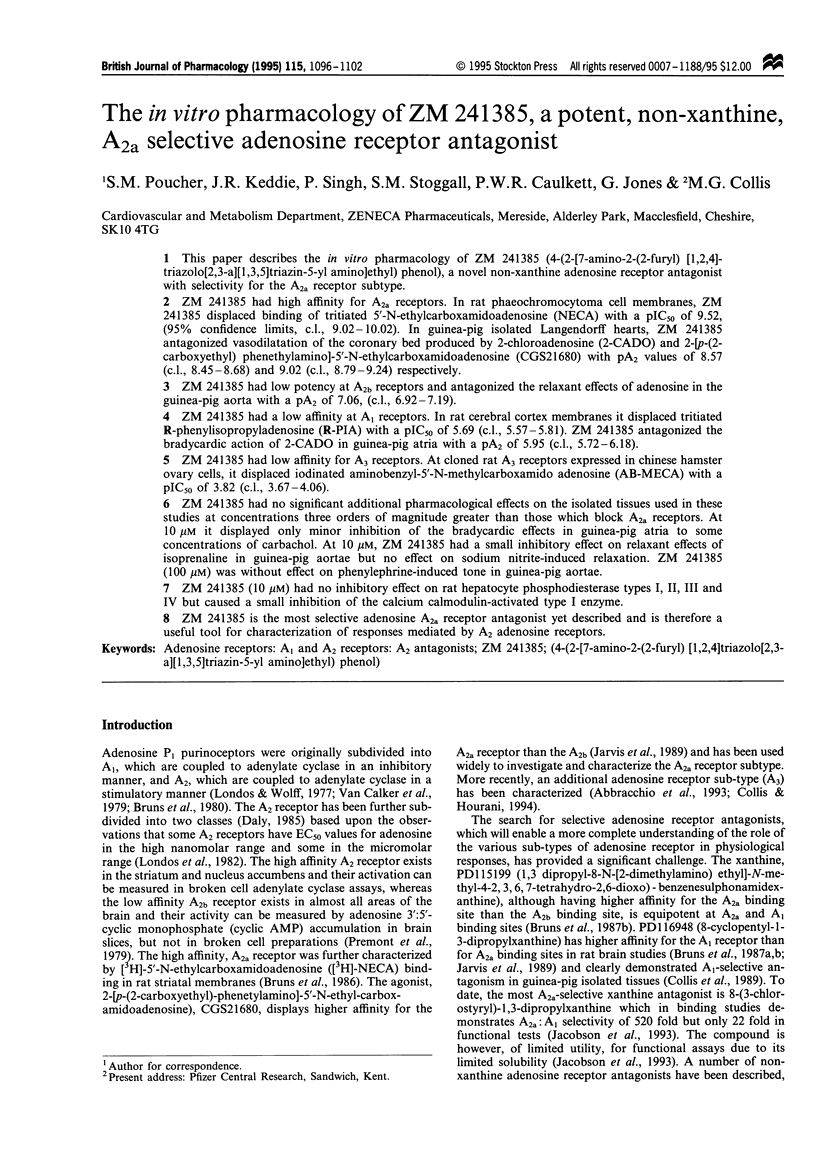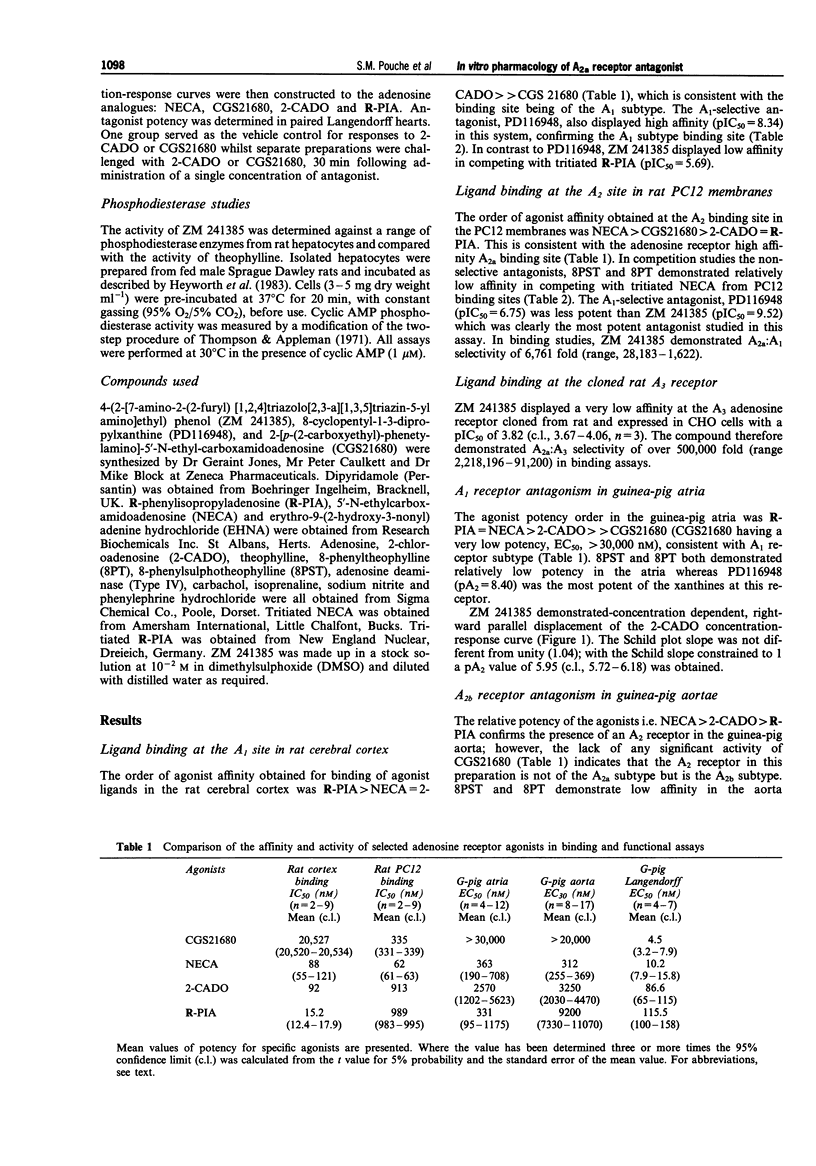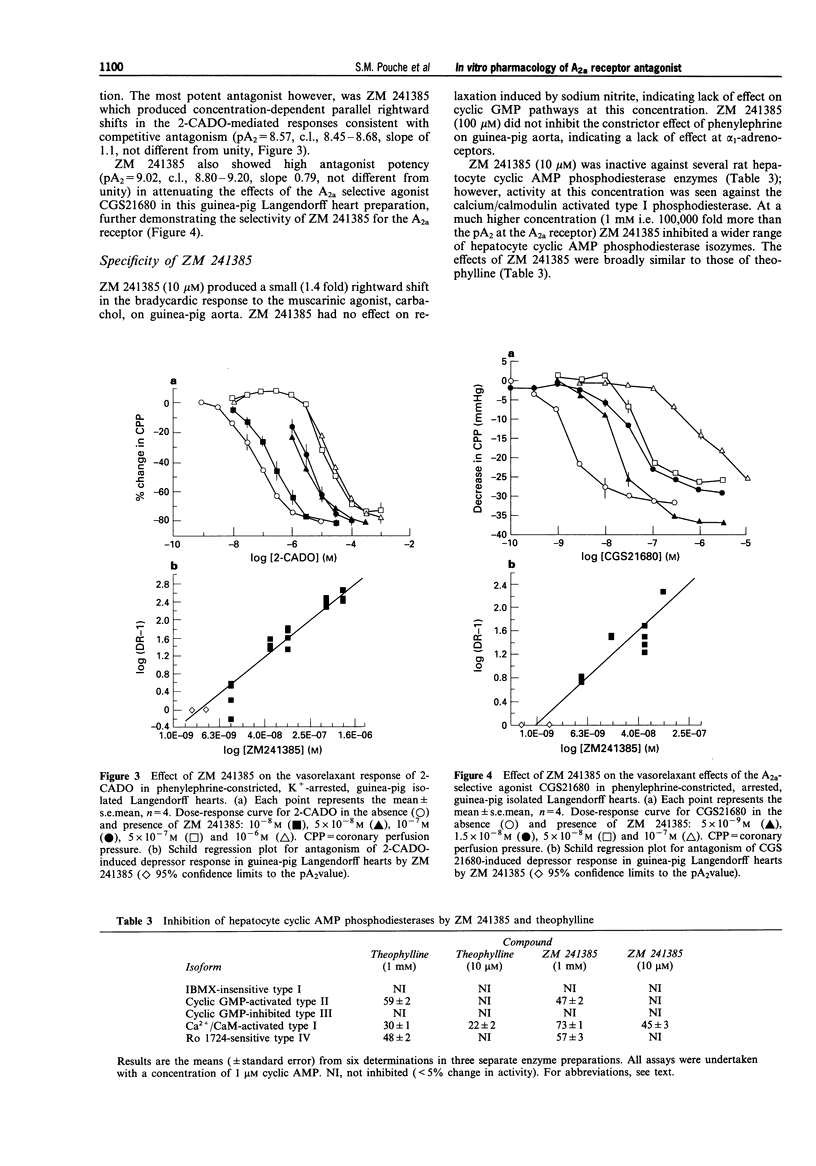Abstract
1. This paper describes the in vitro pharmacology of ZM 241385 (4-(2-[7-amino-2-(2-furyl) [1,2,4]-triazolo[2,3-a][1,3,5]triazin- 5-yl amino]ethyl) phenol), a novel non-xanthine adenosine receptor antagonist with selectivity for the A2a receptor subtype. 2. ZM 241385 had high affinity for A2a receptors. In rat phaeochromocytoma cell membranes, ZM 241385 displaced binding of tritiated 5'-N-ethylcarboxamidoadenosine (NECA) with a pIC50 of 9.52, (95% confidence limits, c.l., 9.02-10.02). In guinea-pig isolated Langendorff hearts, ZM 241385 antagonized vasodilatation of the coronary bed produced by 2-chloroadenosine (2-CADO) and 2-[p-(2-carboxyethyl) phenethylamino]-5'-N-ethylcarboxamidoadenosine (CGS21680) with pA2 values of 8.57 (c.l., 8.45-8.68) and 9.02 (c.l., 8.79-9.24) respectively. 3. ZM 241385 had low potency at A2b receptors and antagonized the relaxant effects of adenosine in the guinea-pig aorta with a pA2 of 7.06, (c.l., 6.92-7.19). 4. ZM 241385 had a low affinity at A1 receptors. In rat cerebral cortex membranes it displaced tritiated R-phenylisopropyladenosine (R-PIA) with a pIC50 of 5.69 (c.l., 5.57-5.81). ZM 241385 antagonized the bradycardic action of 2-CADO in guinea-pig atria with a pA2 of 5.95 (c.l., 5.72-6.18). 5. ZM 241385 had low affinity for A3 receptors. At cloned rat A3 receptors expressed in chinese hamster ovary cells, it displaced iodinated aminobenzyl-5'-N-methylcarboxamido adenosine (AB-MECA) with a pIC50 of 3.82 (c.l., 3.67-4.06). 6. ZM 241385 had no significant additional pharmacological effects on the isolated tissues used in these studies at concentrations three orders of magnitude greater than those which block A2a receptors.(ABSTRACT TRUNCATED AT 250 WORDS)
Full text
PDF






Selected References
These references are in PubMed. This may not be the complete list of references from this article.
- ARUNLAKSHANA O., SCHILD H. O. Some quantitative uses of drug antagonists. Br J Pharmacol Chemother. 1959 Mar;14(1):48–58. doi: 10.1111/j.1476-5381.1959.tb00928.x. [DOI] [PMC free article] [PubMed] [Google Scholar]
- Bruns R. F., Fergus J. H., Badger E. W., Bristol J. A., Santay L. A., Hartman J. D., Hays S. J., Huang C. C. Binding of the A1-selective adenosine antagonist 8-cyclopentyl-1,3-dipropylxanthine to rat brain membranes. Naunyn Schmiedebergs Arch Pharmacol. 1987 Jan;335(1):59–63. doi: 10.1007/BF00165037. [DOI] [PubMed] [Google Scholar]
- Bruns R. F., Fergus J. H., Badger E. W., Bristol J. A., Santay L. A., Hays S. J. PD 115,199: an antagonist ligand for adenosine A2 receptors. Naunyn Schmiedebergs Arch Pharmacol. 1987 Jan;335(1):64–69. doi: 10.1007/BF00165038. [DOI] [PubMed] [Google Scholar]
- Bruns R. F., Lu G. H., Pugsley T. A. Characterization of the A2 adenosine receptor labeled by [3H]NECA in rat striatal membranes. Mol Pharmacol. 1986 Apr;29(4):331–346. [PubMed] [Google Scholar]
- Collis M. G., Brown C. M. Adenosine relaxes the aorta by interacting with an A2 receptor and an intracellular site. Eur J Pharmacol. 1983 Dec 9;96(1-2):61–69. doi: 10.1016/0014-2999(83)90529-0. [DOI] [PubMed] [Google Scholar]
- Collis M. G. Evidence for an A1-adenosine receptor in the guinea-pig atrium. Br J Pharmacol. 1983 Jan;78(1):207–212. doi: 10.1111/j.1476-5381.1983.tb09381.x. [DOI] [PMC free article] [PubMed] [Google Scholar]
- Collis M. G., Hourani S. M. Adenosine receptor subtypes. Trends Pharmacol Sci. 1993 Oct;14(10):360–366. doi: 10.1016/0165-6147(93)90094-z. [DOI] [PubMed] [Google Scholar]
- Collis M. G., Stoggall S. M., Martin F. M. Apparent affinity of 1,3-dipropyl-8-cyclopentylxanthine for adenosine A1 and A2 receptors in isolated tissues from guinea-pigs. Br J Pharmacol. 1989 Aug;97(4):1274–1278. doi: 10.1111/j.1476-5381.1989.tb12589.x. [DOI] [PMC free article] [PubMed] [Google Scholar]
- Daly J. W. Adenosine receptors. Adv Cyclic Nucleotide Protein Phosphorylation Res. 1985;19:29–46. [PubMed] [Google Scholar]
- Dionisotti S., Conti A., Sandoli D., Zocchi C., Gatta F., Ongini E. Effects of the new A2 adenosine receptor antagonist 8FB-PTP, an 8 substituted pyrazolo-triazolo-pyrimidine, on in vitro functional models. Br J Pharmacol. 1994 Jun;112(2):659–665. doi: 10.1111/j.1476-5381.1994.tb13126.x. [DOI] [PMC free article] [PubMed] [Google Scholar]
- Fozard J. R., Carruthers A. M. Adenosine A3 receptors mediate hypotension in the angiotensin II-supported circulation of the pithed rat. Br J Pharmacol. 1993 May;109(1):3–5. doi: 10.1111/j.1476-5381.1993.tb13522.x. [DOI] [PMC free article] [PubMed] [Google Scholar]
- Heyworth C. M., Wallace A. V., Houslay M. D. Insulin and glucagon regulate the activation of two distinct membrane-bound cyclic AMP phosphodiesterases in hepatocytes. Biochem J. 1983 Jul 15;214(1):99–110. doi: 10.1042/bj2140099. [DOI] [PMC free article] [PubMed] [Google Scholar]
- Hide I., Padgett W. L., Jacobson K. A., Daly J. W. A2A adenosine receptors from rat striatum and rat pheochromocytoma PC12 cells: characterization with radioligand binding and by activation of adenylate cyclase. Mol Pharmacol. 1992 Feb;41(2):352–359. [PMC free article] [PubMed] [Google Scholar]
- Jacobson K. A., Nikodijević O., Padgett W. L., Gallo-Rodriguez C., Maillard M., Daly J. W. 8-(3-Chlorostyryl)caffeine (CSC) is a selective A2-adenosine antagonist in vitro and in vivo. FEBS Lett. 1993 May 24;323(1-2):141–144. doi: 10.1016/0014-5793(93)81466-d. [DOI] [PMC free article] [PubMed] [Google Scholar]
- Jarvis M. F., Schulz R., Hutchison A. J., Do U. H., Sills M. A., Williams M. [3H]CGS 21680, a selective A2 adenosine receptor agonist directly labels A2 receptors in rat brain. J Pharmacol Exp Ther. 1989 Dec;251(3):888–893. [PubMed] [Google Scholar]
- Jarvis S. M., Martin B. W., Ng A. S. 2-Chloroadenosine, a permeant for the nucleoside transporter. Biochem Pharmacol. 1985 Sep 15;34(18):3237–3241. doi: 10.1016/0006-2952(85)90340-5. [DOI] [PubMed] [Google Scholar]
- Lohse M. J., Lenschow V., Schwabe U. Interaction of barbiturates with adenosine receptors in rat brain. Naunyn Schmiedebergs Arch Pharmacol. 1984 May;326(1):69–74. doi: 10.1007/BF00518781. [DOI] [PubMed] [Google Scholar]
- Londos C., Wolff J. Two distinct adenosine-sensitive sites on adenylate cyclase. Proc Natl Acad Sci U S A. 1977 Dec;74(12):5482–5486. doi: 10.1073/pnas.74.12.5482. [DOI] [PMC free article] [PubMed] [Google Scholar]
- Martin P. L. Relative agonist potencies of C2-substituted analogues of adenosine: evidence for adenosine A2B receptors in the guinea pig aorta. Eur J Pharmacol. 1992 Jun 5;216(2):235–242. doi: 10.1016/0014-2999(92)90365-b. [DOI] [PubMed] [Google Scholar]
- Moore P. K., Oluyomi A. O., Babbedge R. C., Wallace P., Hart S. L. L-NG-nitro arginine methyl ester exhibits antinociceptive activity in the mouse. Br J Pharmacol. 1991 Jan;102(1):198–202. doi: 10.1111/j.1476-5381.1991.tb12153.x. [DOI] [PMC free article] [PubMed] [Google Scholar]
- Munson P. J., Rodbard D. Ligand: a versatile computerized approach for characterization of ligand-binding systems. Anal Biochem. 1980 Sep 1;107(1):220–239. doi: 10.1016/0003-2697(80)90515-1. [DOI] [PubMed] [Google Scholar]
- Olah M. E., Gallo-Rodriguez C., Jacobson K. A., Stiles G. L. 125I-4-aminobenzyl-5'-N-methylcarboxamidoadenosine, a high affinity radioligand for the rat A3 adenosine receptor. Mol Pharmacol. 1994 May;45(5):978–982. [PMC free article] [PubMed] [Google Scholar]
- Prémont J., Perez M., Blanc G., Tassin J. P., Thierry A. M., Hervé D., Bockaert J. Adenosine-sensitive adenylate cyclase in rat brain homogenates: kinetic characteristics, specificity, topographical, subcellular and cellular distribution. Mol Pharmacol. 1979 Nov;16(3):790–804. [PubMed] [Google Scholar]
- Rollins P. J., Turner S. J., Akpoguma C. I., Ray K. P. Characterisation of human adenosine type 1, 2a and 2b receptors expressed in CHO cells. Biochem Soc Trans. 1994 May;22(2):195S–195S. doi: 10.1042/bst022195s. [DOI] [PubMed] [Google Scholar]
- Smellie F. W., Davis C. W., Daly J. W., Wells J. N. Alkylxanthines: inhibition of adenosine-elicited accumulation of cyclic AMP in brain slices and of brain phosphodiesterase activity. Life Sci. 1979 Jun 25;24(26):2475–2482. doi: 10.1016/0024-3205(79)90458-2. [DOI] [PubMed] [Google Scholar]
- Stoggall S. M., Shaw J. S. The coexistence of adenosine A1 and A2 receptors in guinea-pig aorta. Eur J Pharmacol. 1990 Nov 13;190(3):329–335. doi: 10.1016/0014-2999(90)94197-6. [DOI] [PubMed] [Google Scholar]
- Thompson W. J., Appleman M. M. Multiple cyclic nucleotide phosphodiesterase activities from rat brain. Biochemistry. 1971 Jan 19;10(2):311–316. [PubMed] [Google Scholar]
- Ueeda M., Thompson R. D., Arroyo L. H., Olsson R. A. 2-Alkoxyadenosines: potent and selective agonists at the coronary artery A2 adenosine receptor. J Med Chem. 1991 Apr;34(4):1334–1339. doi: 10.1021/jm00108a014. [DOI] [PubMed] [Google Scholar]
- Ukena D., Jacobson K. A., Padgett W. L., Ayala C., Shamim M. T., Kirk K. L., Olsson R. O., Daly J. W. Species differences in structure-activity relationships of adenosine agonists and xanthine antagonists at brain A1 adenosine receptors. FEBS Lett. 1986 Dec 1;209(1):122–128. doi: 10.1016/0014-5793(86)81096-1. [DOI] [PMC free article] [PubMed] [Google Scholar]
- Williams M., Francis J., Ghai G., Braunwalder A., Psychoyos S., Stone G. A., Cash W. D. Biochemical characterization of the triazoloquinazoline, CGS 15943, a novel, non-xanthine adenosine antagonist. J Pharmacol Exp Ther. 1987 May;241(2):415–420. [PubMed] [Google Scholar]
- Zhou Q. Y., Li C., Olah M. E., Johnson R. A., Stiles G. L., Civelli O. Molecular cloning and characterization of an adenosine receptor: the A3 adenosine receptor. Proc Natl Acad Sci U S A. 1992 Aug 15;89(16):7432–7436. doi: 10.1073/pnas.89.16.7432. [DOI] [PMC free article] [PubMed] [Google Scholar]
- van Calker D., Müller M., Hamprecht B. Adenosine regulates via two different types of receptors, the accumulation of cyclic AMP in cultured brain cells. J Neurochem. 1979 Nov;33(5):999–1005. doi: 10.1111/j.1471-4159.1979.tb05236.x. [DOI] [PubMed] [Google Scholar]


